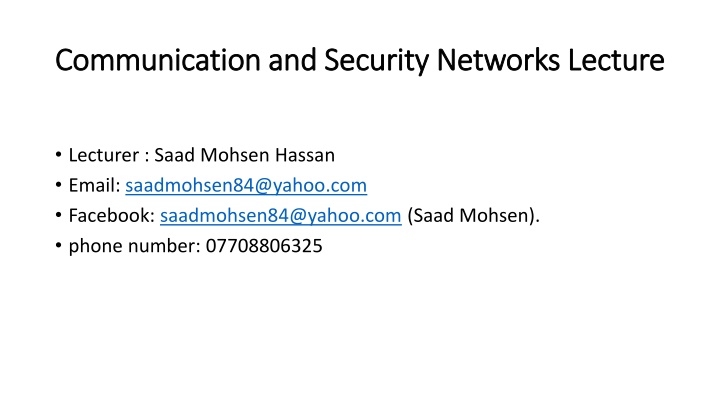
Introduction to Data Communication and Networks: Fundamentals Explained
Explore the fundamental concepts of data communication and computer networks in this lecture by Saad Mohsen Hassan. Learn about data, information, characteristics of data communication, and more. Gain insights into the process of exchanging data over computer networks and the essential elements involved. Discover how data and information play a vital role in decision-making and the smooth exchange of data globally.
Download Presentation

Please find below an Image/Link to download the presentation.
The content on the website is provided AS IS for your information and personal use only. It may not be sold, licensed, or shared on other websites without obtaining consent from the author. If you encounter any issues during the download, it is possible that the publisher has removed the file from their server.
You are allowed to download the files provided on this website for personal or commercial use, subject to the condition that they are used lawfully. All files are the property of their respective owners.
The content on the website is provided AS IS for your information and personal use only. It may not be sold, licensed, or shared on other websites without obtaining consent from the author.
E N D
Presentation Transcript
Communication and Communication and Security Networks Security Networks Lecture Lecture Lecturer : Saad Mohsen Hassan Email: saadmohsen84@yahoo.com Facebook: saadmohsen84@yahoo.com (Saad Mohsen). phone number: 07708806325
1.1 1.1 INTRODUCTION INTRODUCTION This Lecture provides an introduction to computer networks and covers fundamental topics like data, information to the definition of communication and computer networks. The main objective of data communication and networking is to enable seamless exchange of data between any two points in the world. This exchange of data takes place over a computer network. . . .
1.2 1.2 DATA & INFORMATION DATA & INFORMATION Data: refers to the raw facts that are collected while. Data is defined as the collection of facts and details like text, figures, observations, symbols. . : .
Information: refers to processed data that enables us to take decisions. Information is described as that form of data which is processed, organized, and specific and structured, which is presented in the given setting. . : .
1.3 1.3 DATA COMMUNICATION DATA COMMUNICATION Data Communication is a process of exchanging data or information In case of computer networks this exchange is done between two devices over a transmission medium. This process involves a communication system which is made up of hardware and software. The hardware part involves the sender and receiver devices and the intermediate devices through which the data passes. The software part involves certain rules which specify what is to be communicated, how it is to be communicated and when. It is also called as a Protocol. The following sections are describes the fundamental characteristics that are important for the effective working of data communication process and is followed by the components that make up a data communications system.
1.3.1 1.3.1 Characteristics of Data Communication Characteristics of Data Communication 1. Delivery: The data should be delivered to the correct destination and correct user. 2. Accuracy: The communication system should deliver the data accurately, without introducing any errors. The data may get corrupted during transmission affecting the accuracy of the delivered data. 3. Timeliness: Audio and Video data has to be delivered in a timely manner without any delay; such a data delivery is called real time transmission of data. 4. Jitter: It is the variation in the packet arrival time. Uneven Jitter may affect the timeliness of data being transmitted.
1 1.3.2 3.2 Components of Data Communication Components of Data Communication
1. Message: Message is the information to be communicated by the sender to the receiver. 2. Sender: The sender is any device that is capable of sending the data (message). 3. Receiver: The receiver is a device that the sender wants to communicate the data (message). 4. Transmission Medium: It is the path by which the message travels from sender to receiver. It can be wired or wireless. 5. Protocol: It is an agreed upon set or rules used by the sender and receiver to communicate data.
1.4 1.4 DATA REPRESENTATION DATA REPRESENTATION 1. Text: Text includes combination of alphabets. It is stored as a pattern of bits. Prevalent encoding system : ASCII. 2. Numbers: Numbers include combination of digits from 0 to 9. 3. Images 4. Audio: Data can also be in the form of sound which can be recorded and broadcasted. Example: What we hear on the radio is a source of data or information. Audio data is continuous, not discrete. 5. Video: Video refers to broadcasting of data in form of picture or movie








